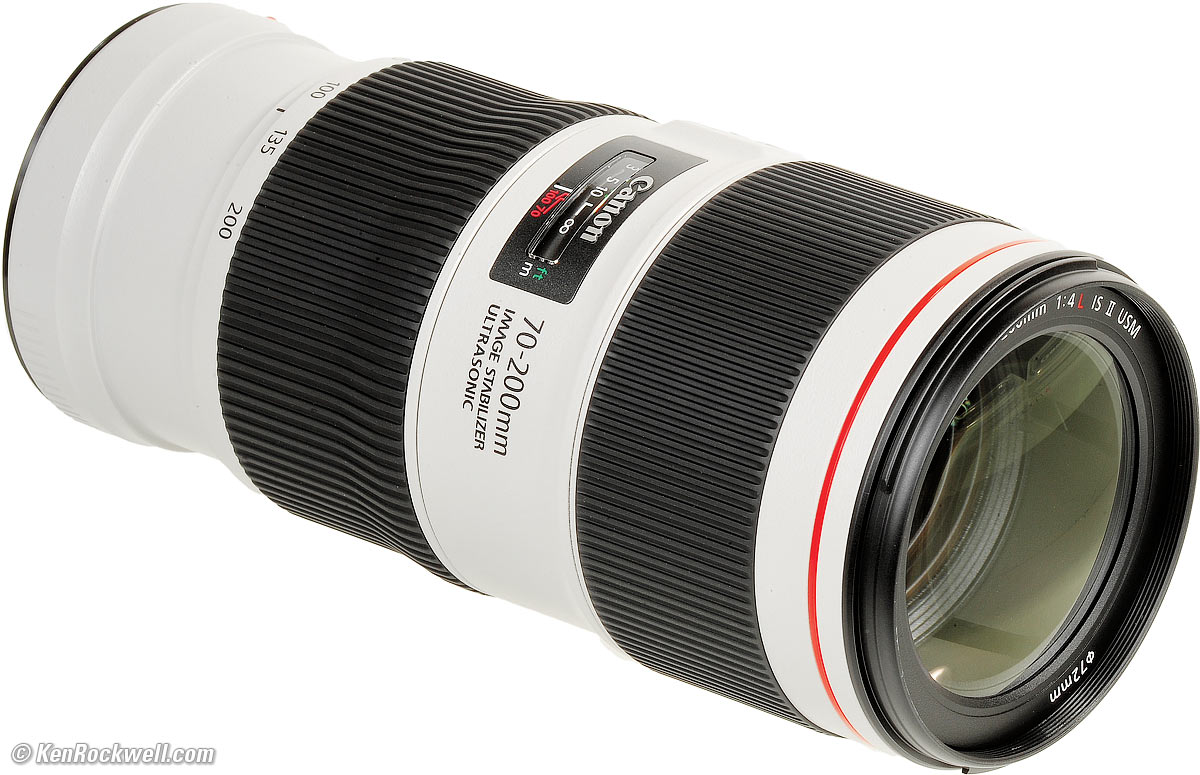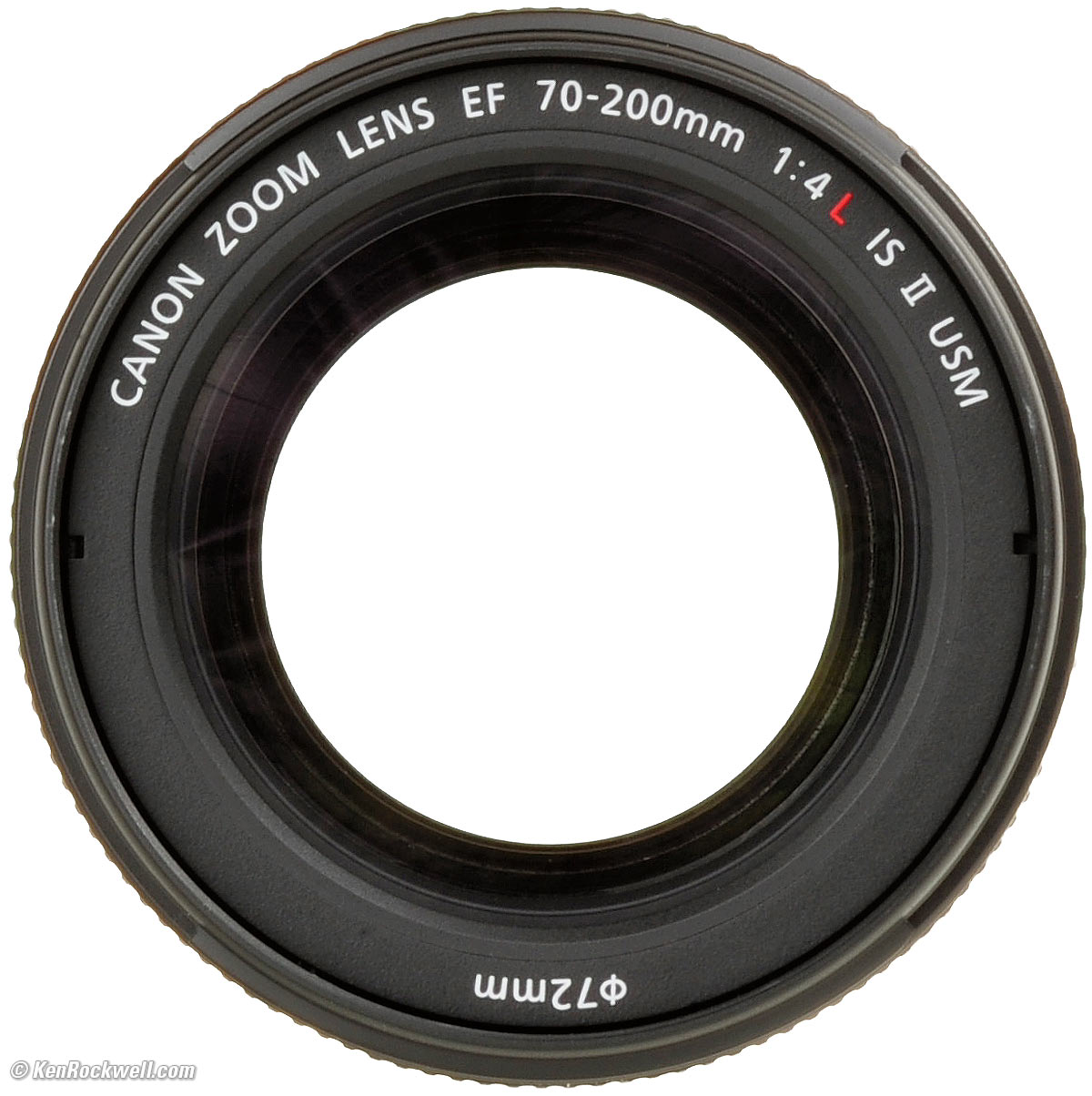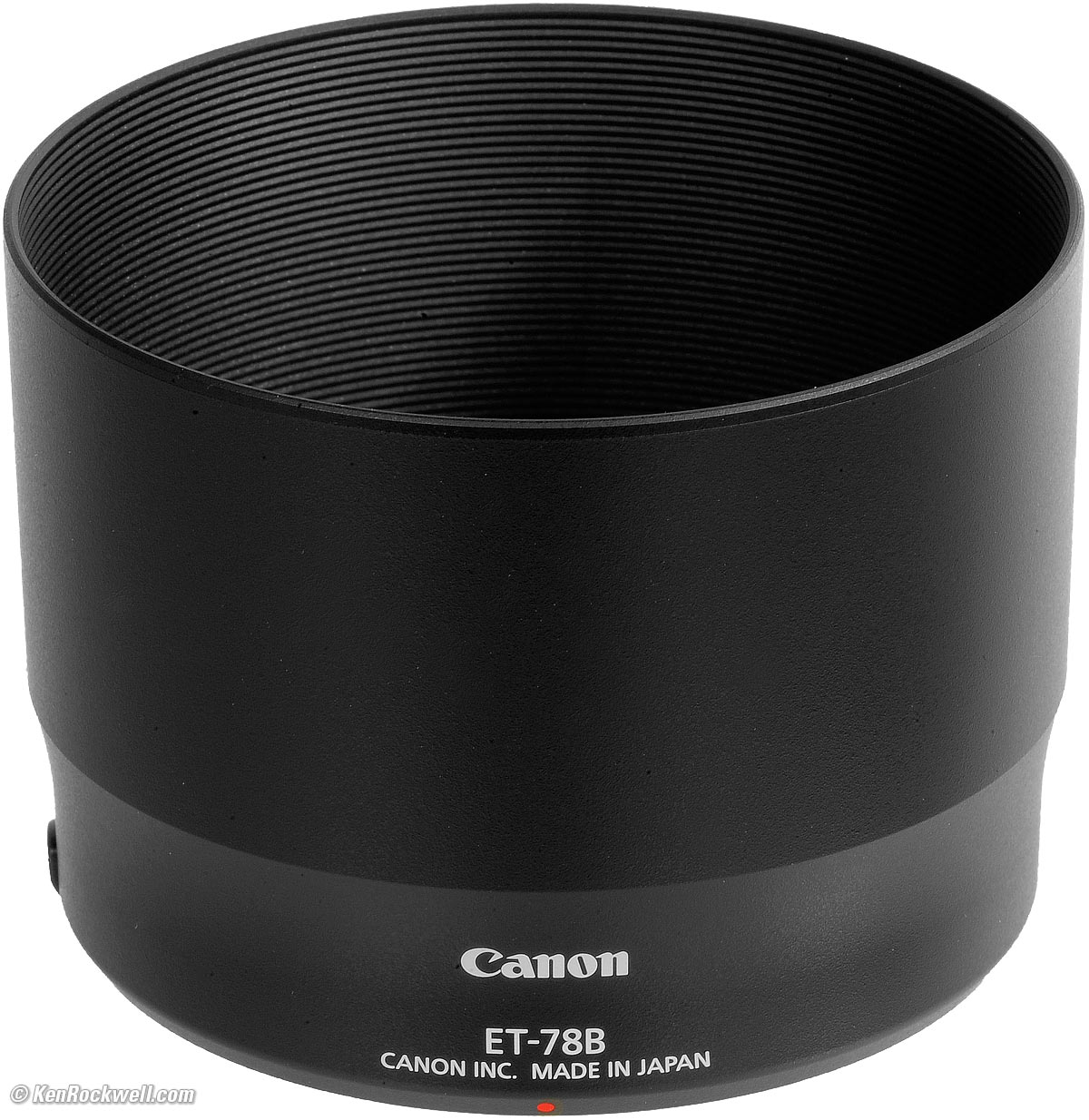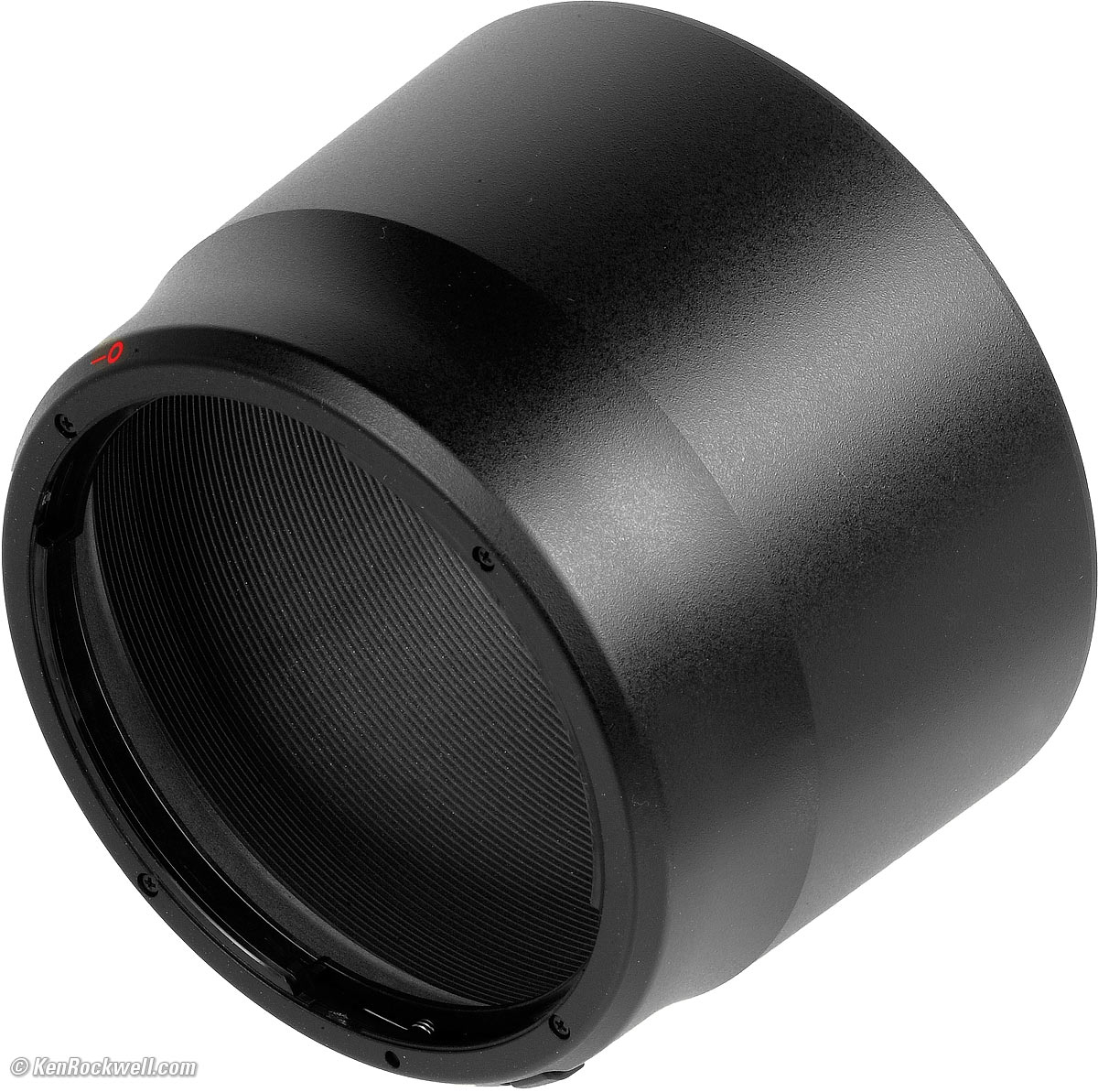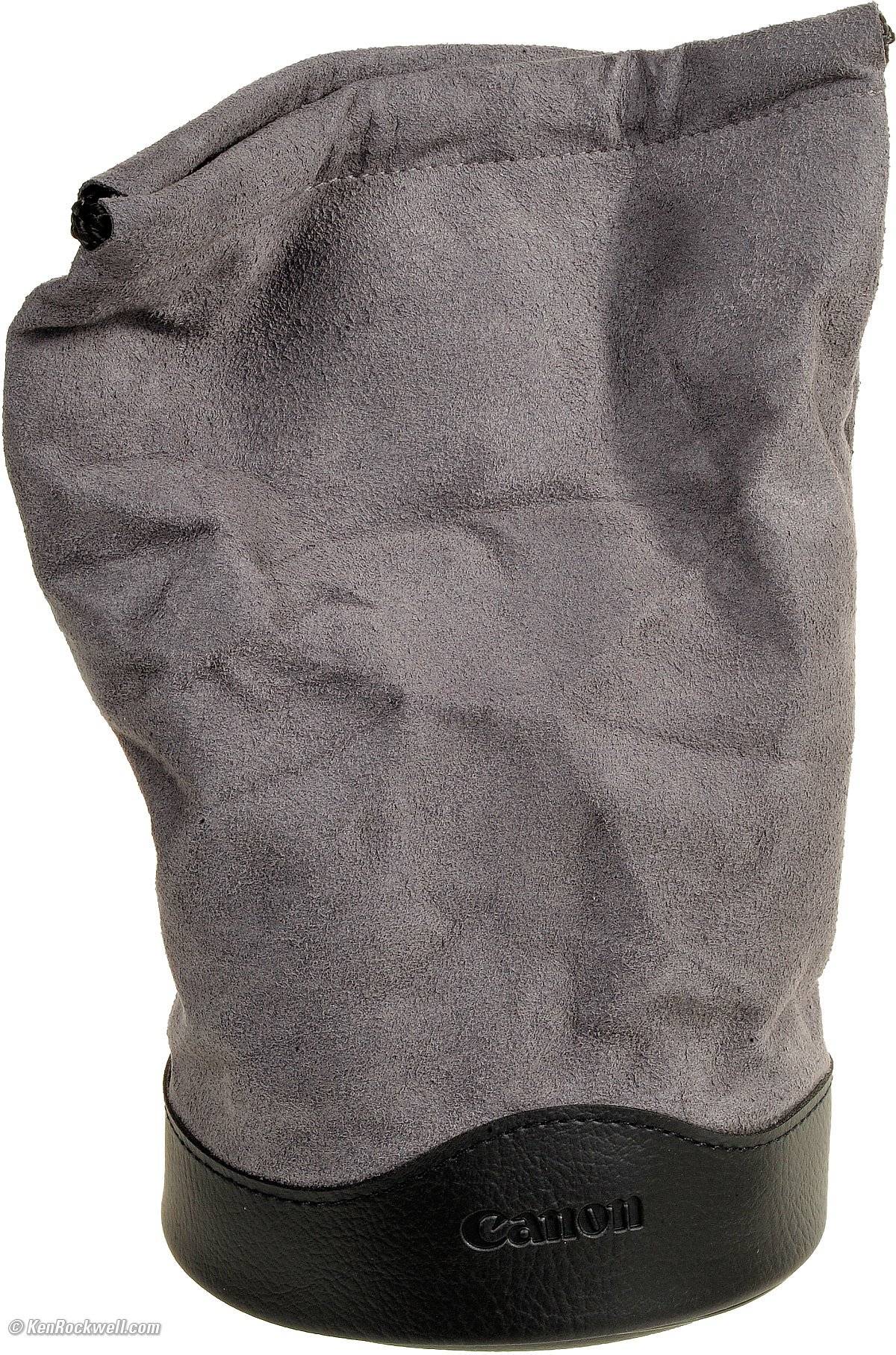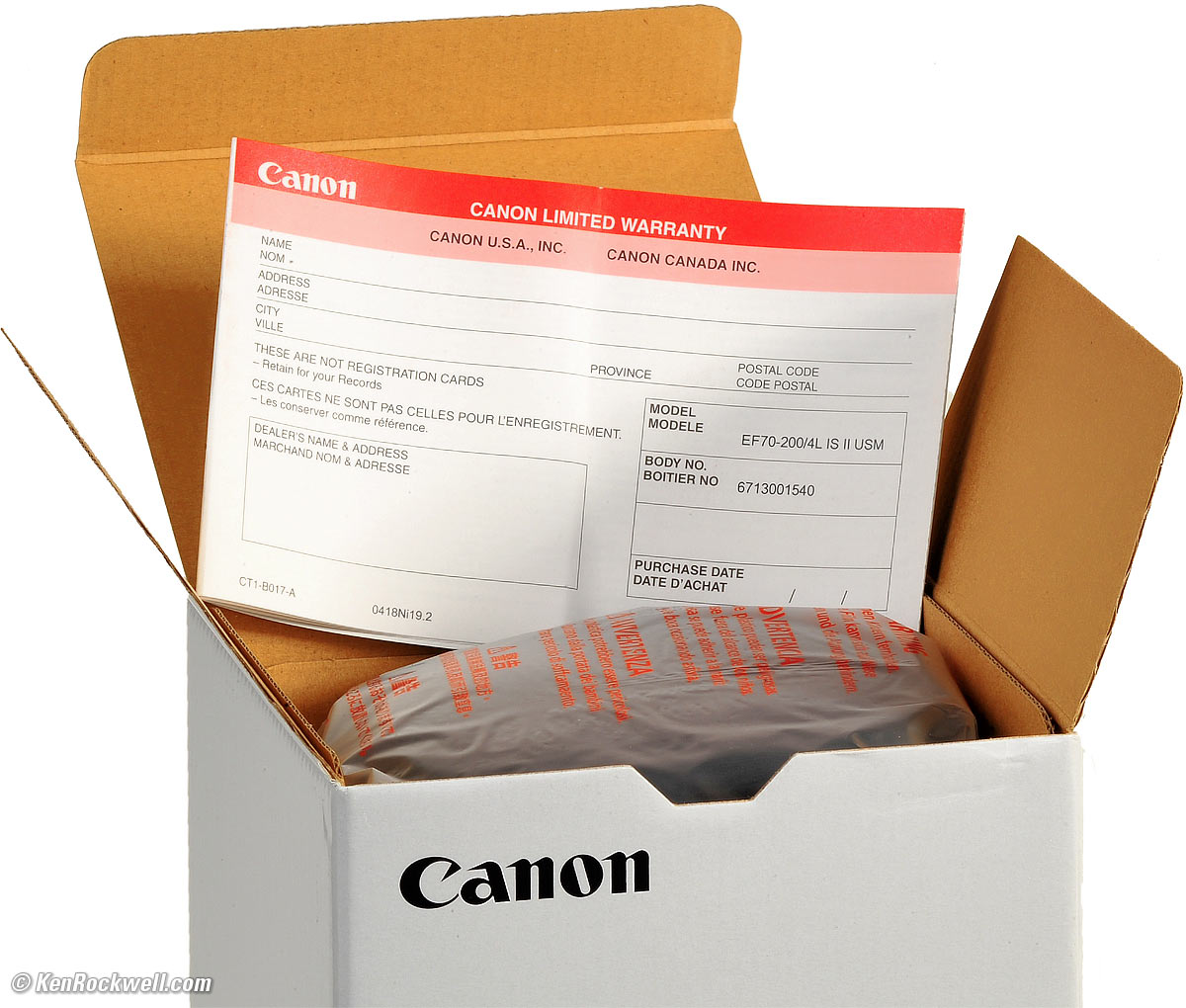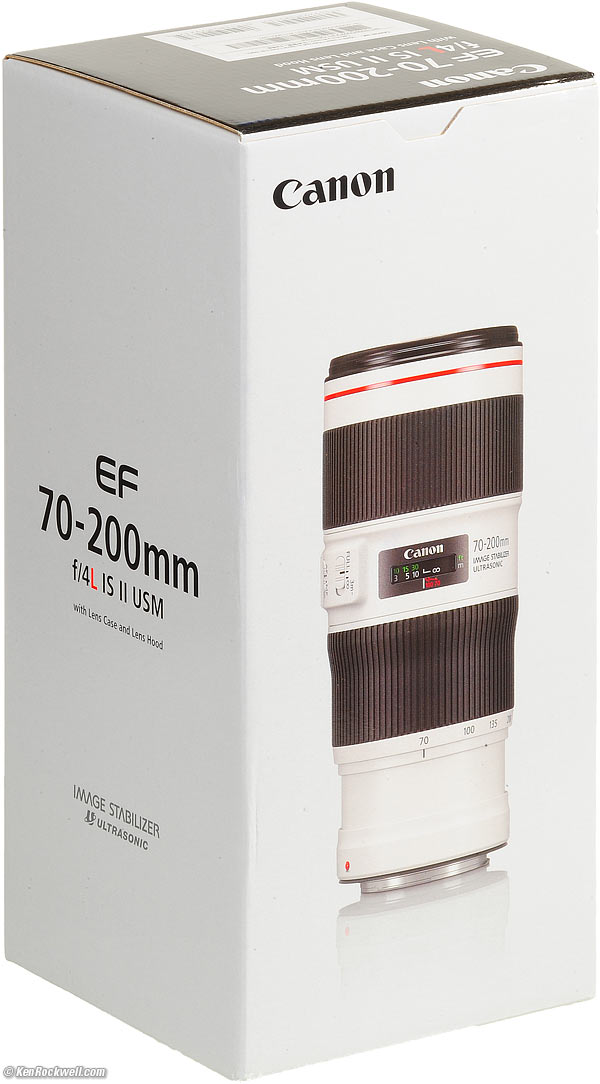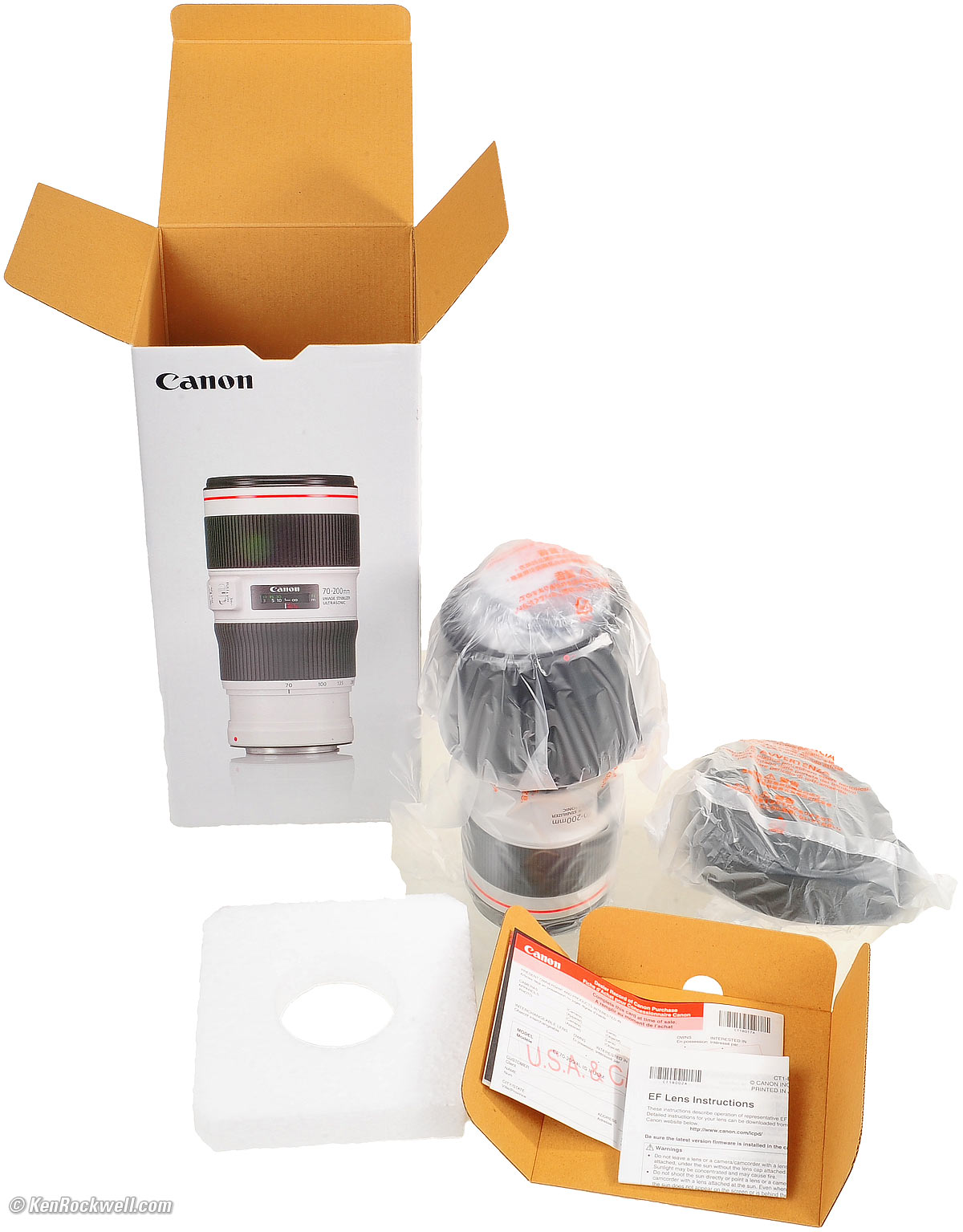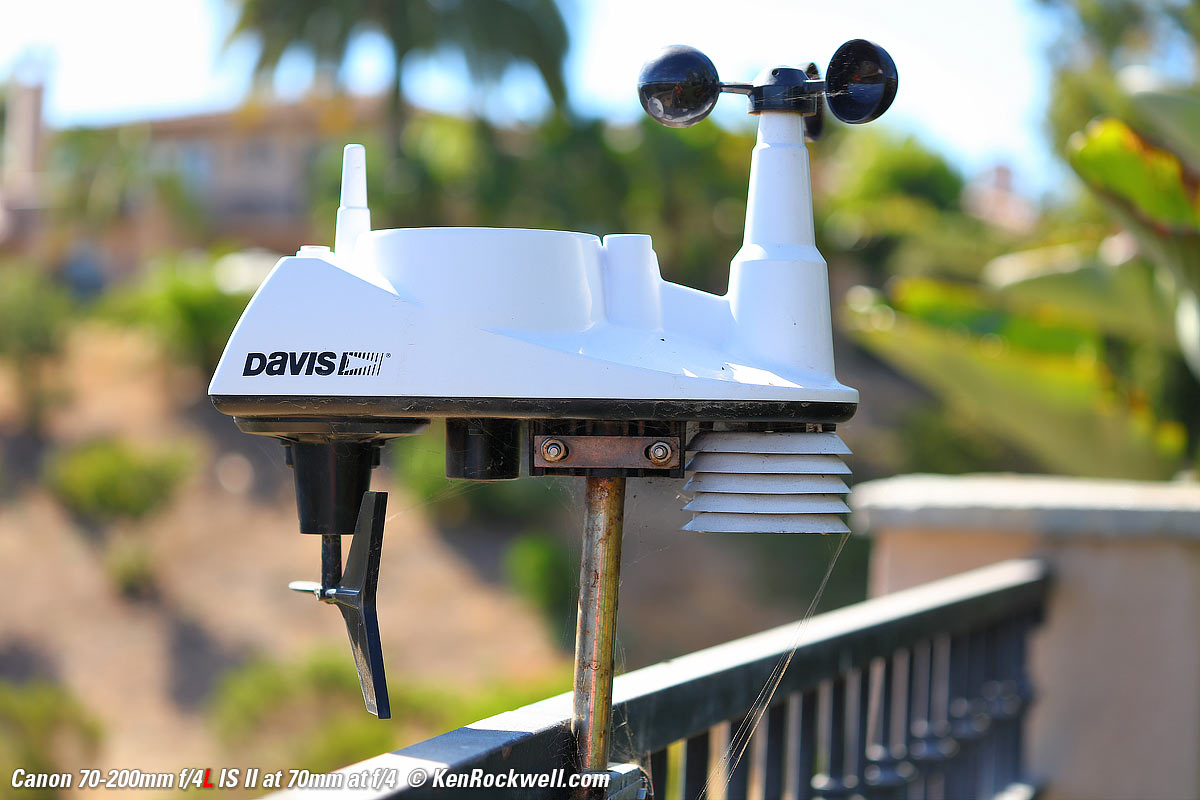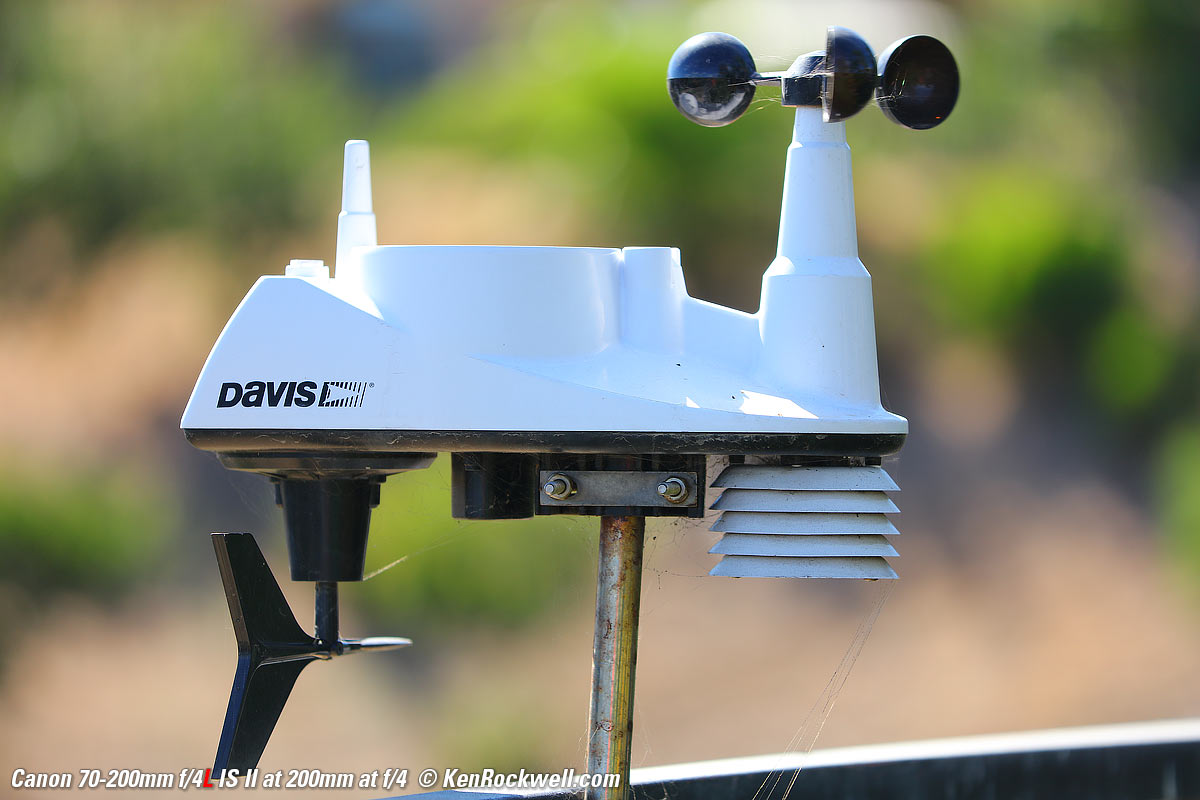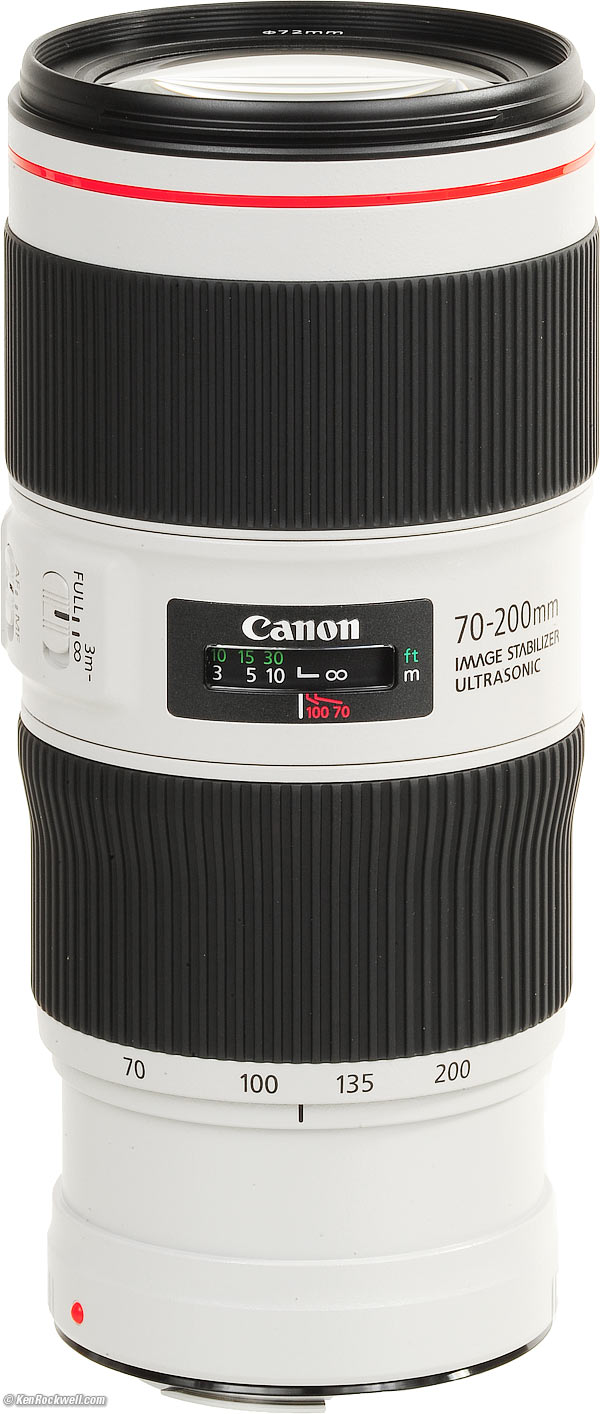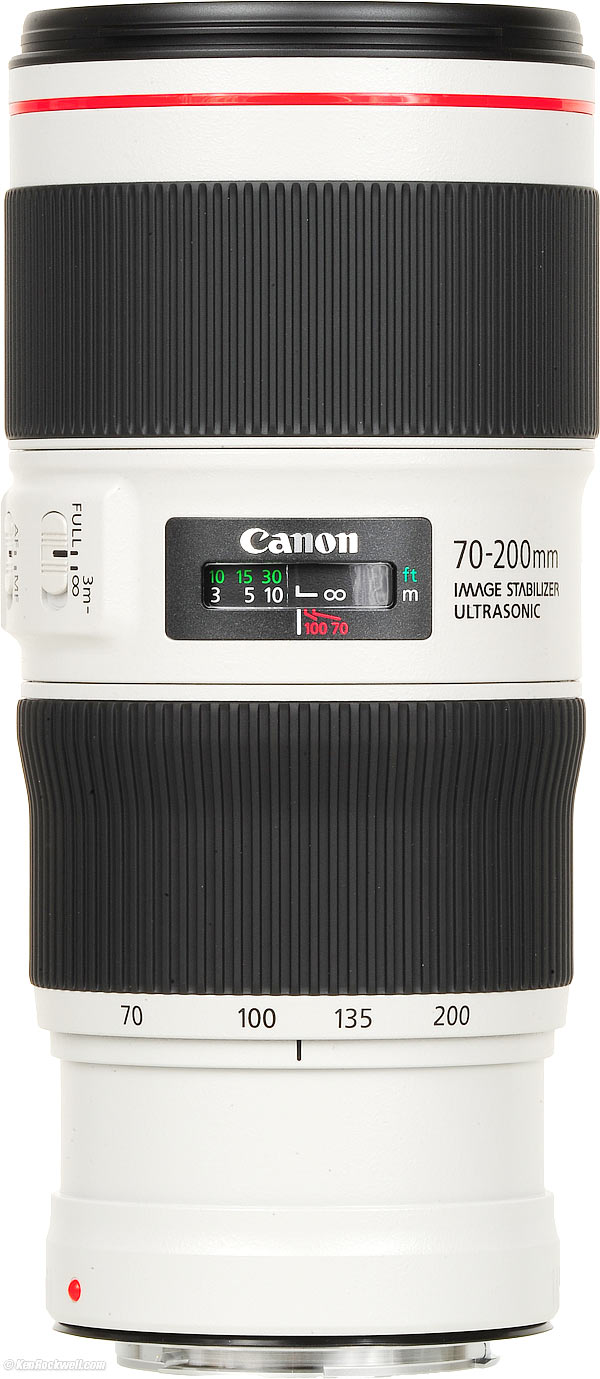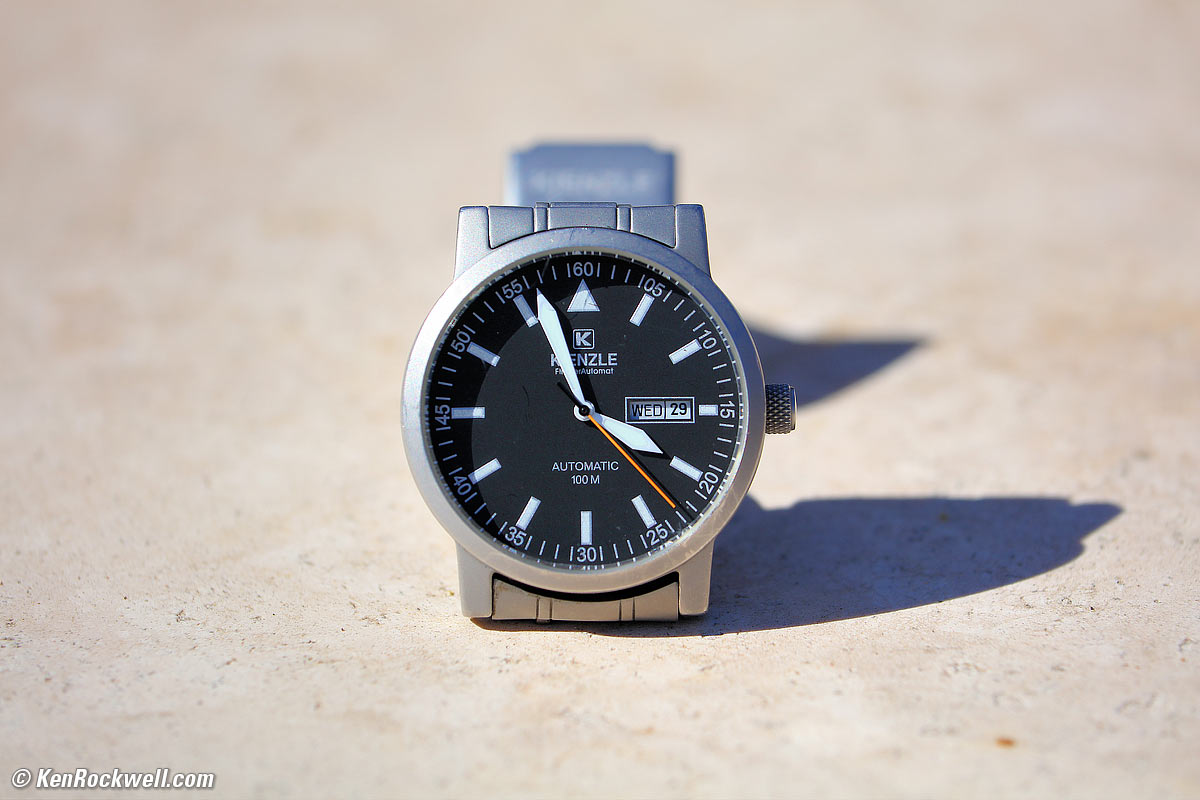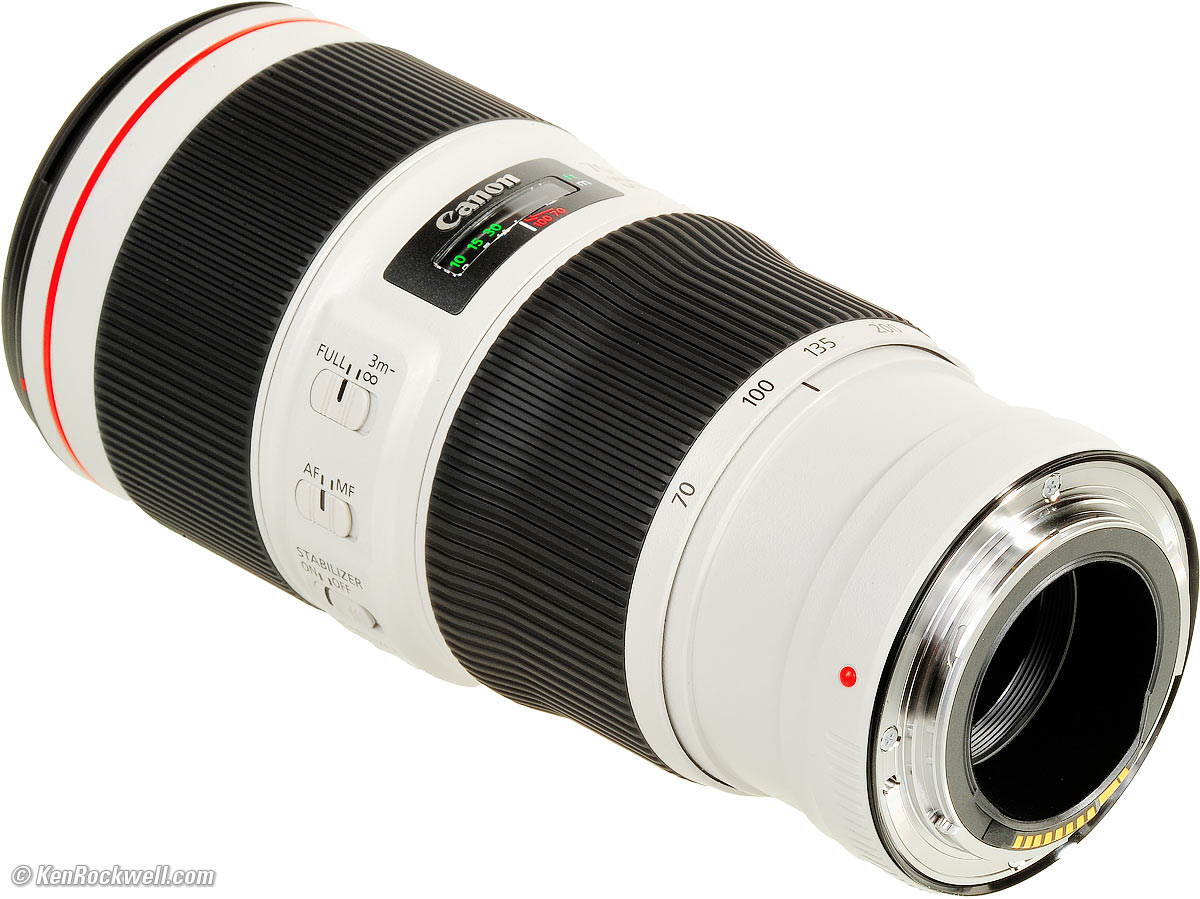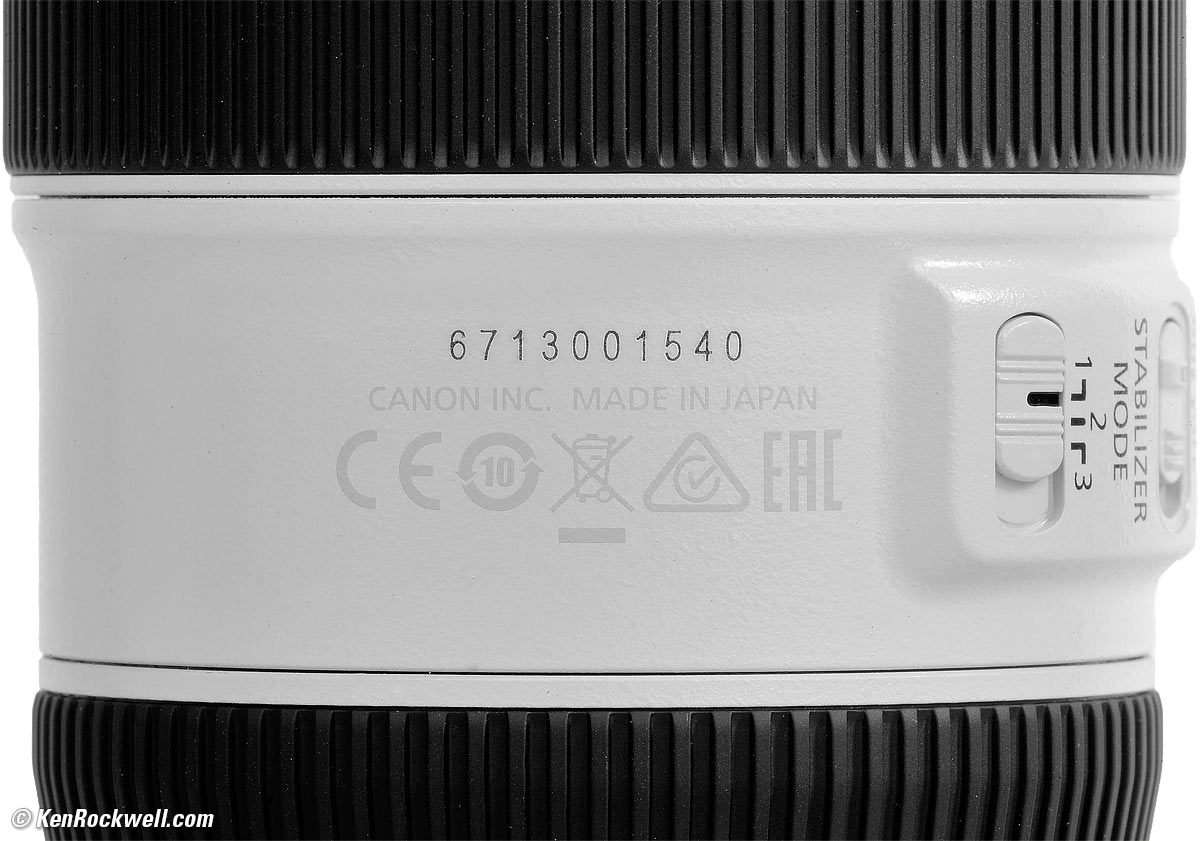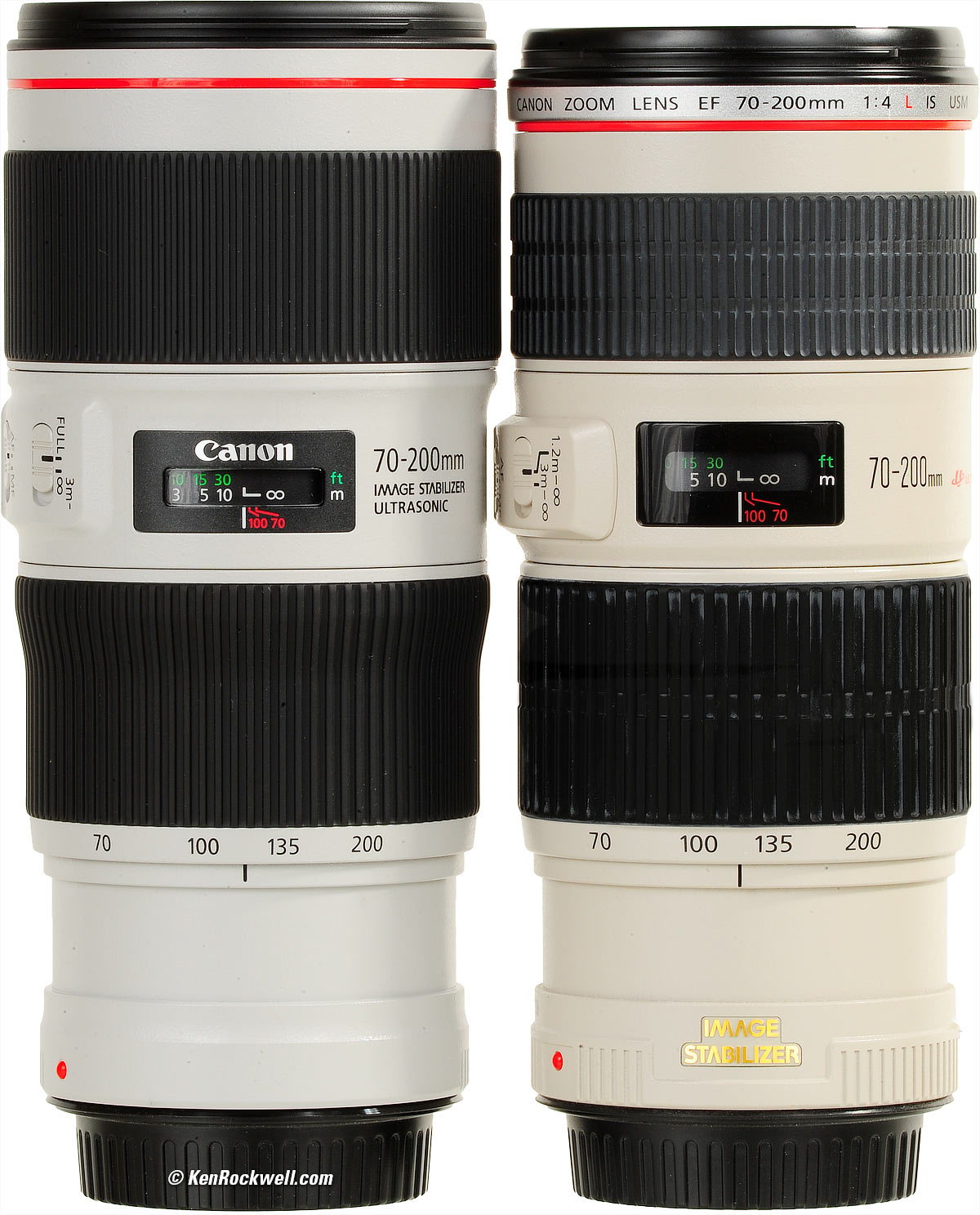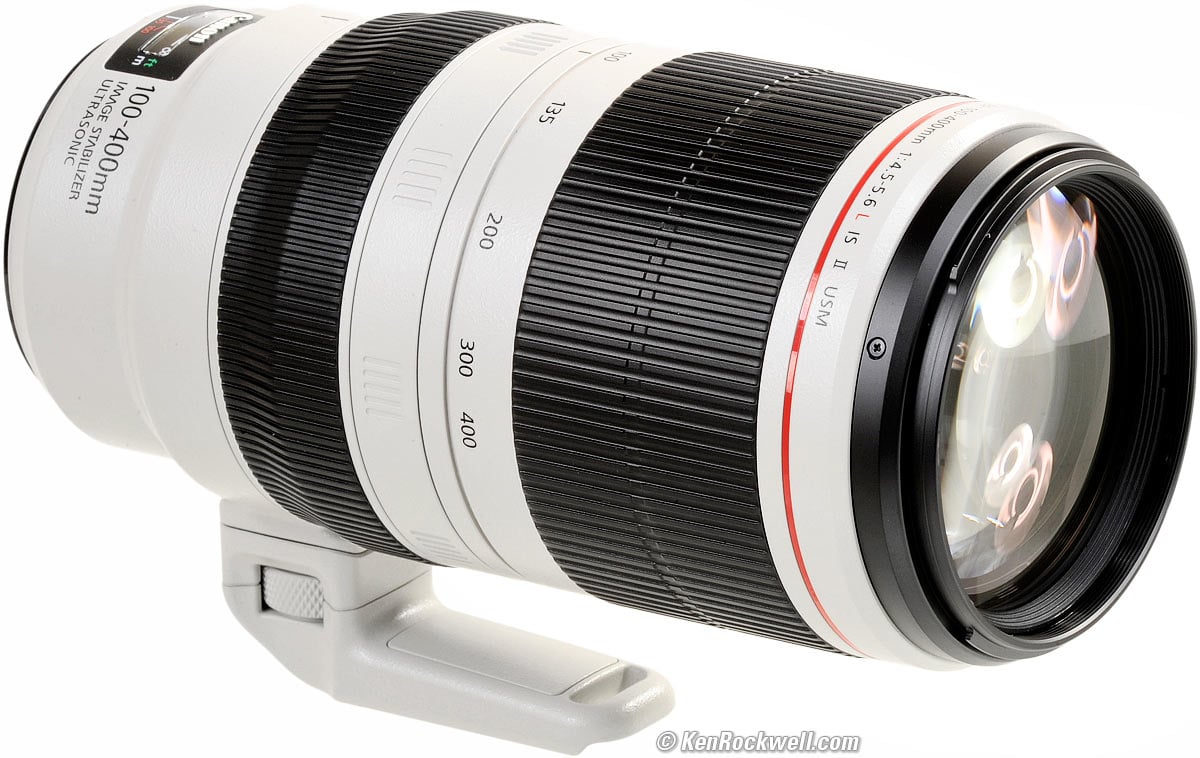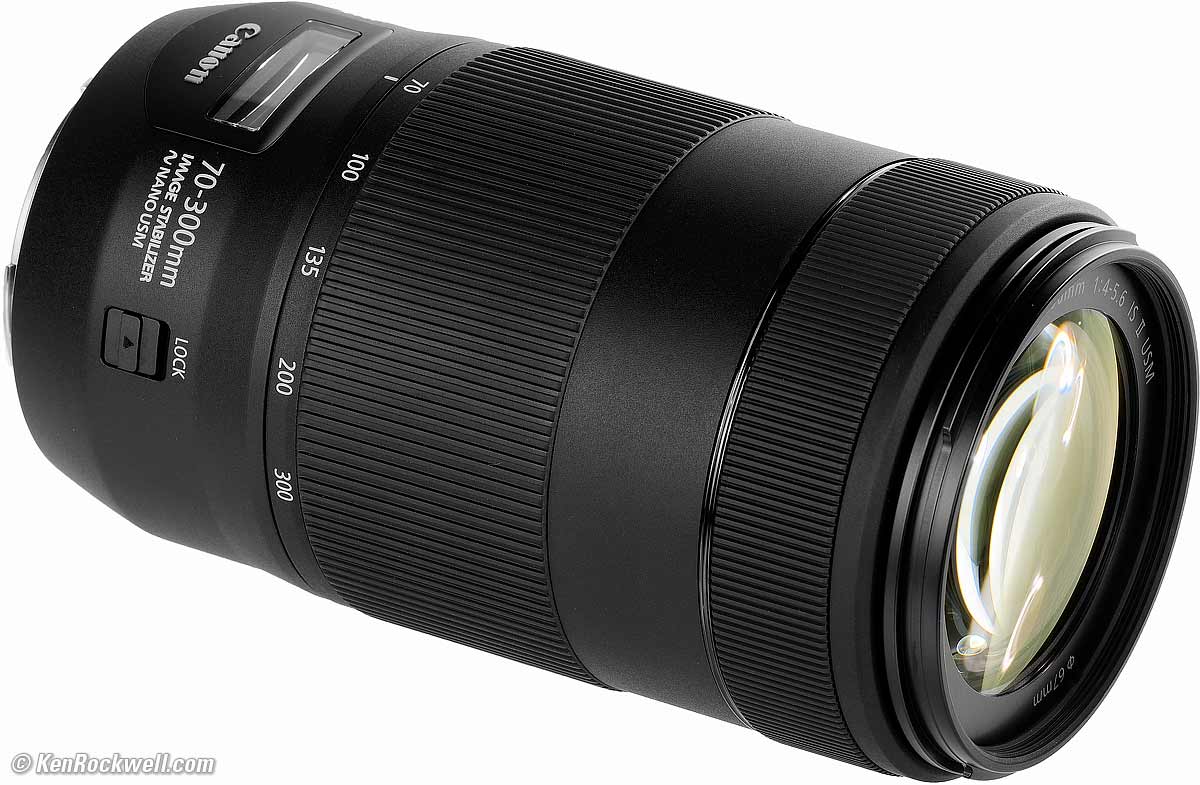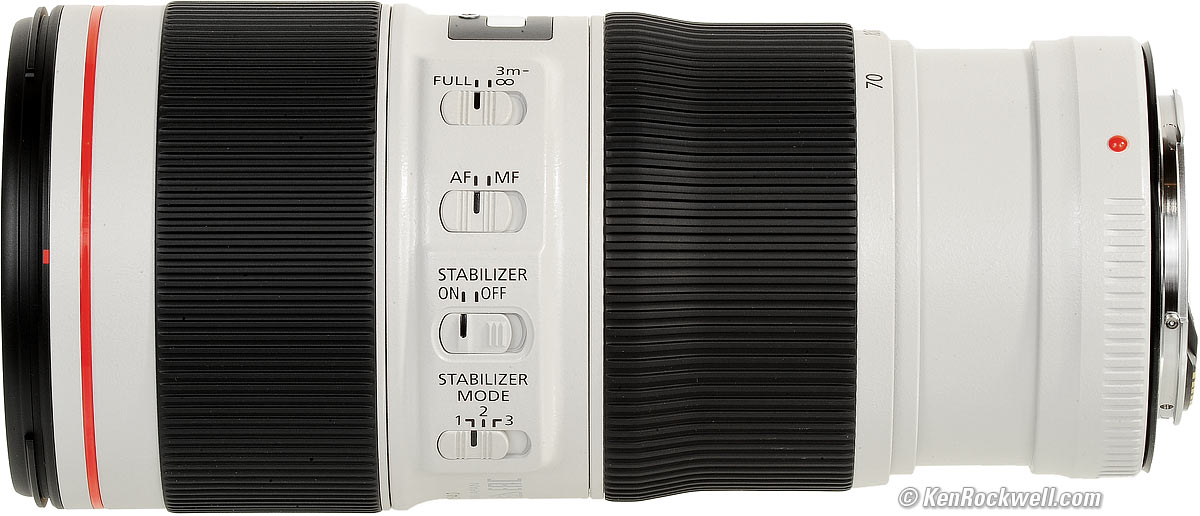Canon 70-200mm f/4L IS II
Full-Frame EF (2018-)
Canon EF 70-200mm f/4L IS II (72mm filters, 27.6 oz./782g, 3.3'/1m close focus, $1,297) bigger.
I got mine at B&H. I'd also get it at Adorama, at Amazon or at Crutchfield.
This all-content, junk-free website's biggest source of support is when you use those or any of these links to my personally-approved sources when you get anything, regardless of the country in which you live. Canon does not seal its boxes in any way, so never buy at retail or any other source not on my personally approved list since you'll have no way of knowing if you're missing accessories, getting a defective, damaged, returned, non-USA, store demo or used lens. Get yours only from the approved sources I use myself for the best prices, service, return policies and selection. Thanks for helping me help you! Ken.
September 2018 Canon Reviews Canon Lenses Canon Flash All Reviews
Original 70-200mm f/4L IS review (2006-2018)
Introduction
Top Intro Format Compatibility
|
I buy only from these approved sources. I can't vouch for ads below. |
This new 70-200mm f/4L IS II is Canon's best 70-200mm lens ever.
This Canon EF 70-200mm f/4L IS II might just be the sharpest zoom lens ever. It's ultrasharp even wide-open at f/4 in the corners of full-frame at 50 megapixels. You can't get better than this, and this lens handles well, has great image stabilization and is well priced.
You can pay more for the huge f/2.8 models if you don't mind hauling a gigantic lens around, but this f/4 lens is at least as sharp, has about the same ability to defocus backgrounds as the f/2.8 lenses (try it yourself and see), and is much smaller and easier to pack, hold and shoot all day. It's a joy to shoot with this lens, and its images are limited only by your own talent, not this extraordinary lens' optics.
This 70-200mm f/4L IS II packs superb optics and performance into a small, compact and low priced package. There's no need for the huge f/2.8 lenses of the past unless you're still shooting film, with which cameras this lens is also 100% compatible.
This lens, like its predecessor, is ultra-ultra-ultrasharp (complete with an exotic fluorite element), focuses fast and has a great image stabilizer so you can forget about tripods. The only reason not to get this lens is if you want 50% more reach at a 50% lower price, in which case you want the Canon 70-300mm IS II, or if you want 100% more reach for 50% more dollars in the much bigger and heavier 100-400mm L IS II.
This new -II lens improves on many of the great things about the original 70-200mm f/4L IS:
New over the original 70-200mm f/4L IS
 Image Stabilization (IS) is now rated for 5 stops, up from the original 70-200mm f/4L IS' 3 stops.
Image Stabilization (IS) is now rated for 5 stops, up from the original 70-200mm f/4L IS' 3 stops.
 Now has three IS modes.
Now has three IS modes.
 Quieter IS operation.
Quieter IS operation.
 Closer focus, now as close as 1m (3.3') versus 1.2m (3.9').
Closer focus, now as close as 1m (3.3') versus 1.2m (3.9').
 9 blade diaphragm versus 8 blades.
9 blade diaphragm versus 8 blades.
 Fluorine coatings to resist dirt and smudges.
Fluorine coatings to resist dirt and smudges.
Good
 Superb optics and stabilization in a compact package.
Superb optics and stabilization in a compact package.
 Low price.
Low price.
 Great construction quality.
Great construction quality.
 Made in Japan.
Made in Japan.
Bad
 Absolutely nothing.
Absolutely nothing.
Missing
 Tripod collar not included; it's the optional Tripod Mount Ring AII (WII).
Tripod collar not included; it's the optional Tripod Mount Ring AII (WII).
Format
Top Intro Format Compatibility
This is a full frame lens, and I'm reviewing it as such.
It works great on APS-C cameras, too, on which you may make the usual inferences.
Compatibility
Top Intro Format Compatibility
This lens works flawlessly on every Canon DSLR and EOS SLR made since 1987.
It work flawlessly on every Canon full-frame and every Canon APS-C DSLR.
It also works flawlessly on every 35mm EOS camera, like my Canon EOS 1V, introduced in 2000, and original 1987 Canon EOS 620.
This isn't Nikon; with Canon, everything just works, even if the camera is over thirty years old. I actually tried it on my 1987 EOS 620 and stabilization works great and autofocus is super-fast.
Use the EOS-M adapter to use this on Canon's EOS-M mirrorless cameras.
Specifications
Top Intro Format Compatibility
Name
Canon calls this the Canon EF 70-200mm f/4L IS II USM
EF: Electronic Focus, as all Canon's lenses have been since 1987.
L: Expensive as L.
IS: Image Stabilization.
II: Canon's second version of this lens.
USM: Ultrasonic Autofocus Motor.
Optics

Canon EF 70-200mm f/4L IS II internal construction. Fluorite and UD elements. IS section.
20 elements in 15 groups.
1 fluorite element for extreme sharpness.
2 UD extra-low dispersion elements, which help reduce secondary axial chromatic aberration.
Fluorine coatings on front and rear to resist dirt and smudges.
Coverage
Full-Frame, 35mm and APS-C.
Diaphragm
At 200mm at f/4, EF diaphragm not seen. bigger.
9 rounded blades.
Stops down to f/32.
Focal Length
70-200mm.
When used on Canon's APS-C cameras, it sees the same angle of view as a 115-325 mm lens sees when used on a full-frame or 35mm camera.
See also Crop Factor.
Angle of View, Full-Frame
34º ~ 12º diagonal.
29º ~ 10º horizontal.
19.5º ~ 7º vertical.
Autofocus
Internal focus with Ring Ultrasonic Motor
No external movement as focused, so no air or dust is sucked in.
Focus Scale
Yes.
Infinity Focus Stop
No.
Depth of Field Scale
No.
Reproduction Ratio Scale
No.
Infrared Focus Indices
Yes.
Close Focus
3.3 feet (1 meter).
Maximum Reproduction Ratio
1:3.7 (0.27 ×).
Image Stabilizer
Rated 5 stops improvement.
Filters
72 mm filter thread.
Hood
Canon ET-78B hood, included. bigger.
Canon ET-78B hood, included. bigger.
Canon ET-78B hood, included.
Case
Canon LP1224, included. bigger.
LP1224, included.
Tripod Collar
The Tripod Mount Ring AII (WII) is optional.
I measure the lens' tripod mount surface as 65.25mm in diameter and 18.25mm wide, the same as I measure the original 70-200/4L IS, so a collar for one ought to fit the other.
Size
3.1" maximum diameter × 6.9" extension from flange.
80 mm maximum diameter × 176 mm extension from flange.
Weight
27.575 oz. (781.75g), actual measured.
Rated 27.5 oz. (780 g).
Announced
12:01AM, Thursday, 07 June 2018.
Promised for
Late June 2018.
Included
72mm front and rear caps.
ET-78B hood.
LP1224 case.
No tripod mount.
Canon Model Numbers
EF70-20040LIS2.
2309C002 (USA) and 2309C001 (Japan).
JAN 4549292-095135.
Price, USA
$1,297, June~September 2018. (185,000 yen in Japan at introduction.)
Accessories
Top Intro Format Compatibility
LP1224 case, included.
Canon Tripod Mount Ring AII (WII), optional. I measure the lens' tripod mount surface as 65.25mm in diameter and 18.25mm wide, the same as I measure the original 70-200/4L IS, so a collar for one ought to fit the other.
Canon ET-78B hood, included.
Teleconverters
Yes, works with the Canon 1.4x and 2x teleconverters. See Teleconverter Performance.
Extension Tubes
Getting a Legal USA Version
Top Intro Format Compatibility
This section applies in the USA only.
Canon EF 70-200mm f/4L IS II. bigger.
Your lens must include a USA warranty card like the one shown above from Canon U.S.A., Inc. It should be on top inside your box as you open it. The serial number on the card must match the serial number engraved on the bottom of your lens.
If not, you got ripped off with a gray market version from another country. This is why I never buy anyplace other than from my personally approved sources. You just can't take the chance of buying elsewhere, especially at any retail store, because non-USA versions have no warranty in the USA, and you probably won't be able to get firmware or service for it — even if you're willing to pay out-of-pocket for it when you need it!
Shifty dealers may include color copies of a card from a legitimate USA lens in a gray-market box, hoping you won't check serial numbers and catch their fraud. A card with the wrong serial number means nothing other than that you have no warranty coverage.
The serial number on the box doesn't have to match, but it should. It will be hidden someplace on the sticker with all the bar codes. If not, it means a shady dealer took things out of boxes and was too sloppy to put them back correctly — and it means you got a used lens if anyone other than you took it out of the box.
If a gray market version saves you $600 the risk might be worth it, but for $200 or less I wouldn't risk having no warranty or support.
Always be sure to check yours while you can still return it, or just don't buy from unapproved sources or at retail so you'll be able to have your camera serviced and get free updated firmware as needed. Get yours from the same places I do and you won't have a problem.
Unboxing
Top Intro Format Compatibility
It comes in a microcorrugated cardboard box:
Box, Canon EF 70-200mm f/4L IS II. bigger.
Pop open the top and you should see a (folded) warranty card on top of your LP1224 sack:
Warranty card and LP1224 sack. bigger.
Pull out the card and sack and cardboard carrier, and you'll see a white foam square.
Pull out the foam square, and you can reach in and pull out your brand-new lens, wrapped in plastic along with your new hood:
Box Contents, Canon EF 70-200mm f/4L IS II. bigger.
Performance
Top Intro Format Compatibility
Overall Autofocus Manual Focus Breathing
Bokeh Distortion Ergonomics Falloff Filters
Lateral Color Fringes Macro Mechanics
Sound & Noise Sharpness Teleconverters
Overall
I try not to spend too much time on this, but the Canon EF 70-200mm f/4L IS II might just be the sharpest zoom lens ever. It's ultrasharp even wide-open at f/4 in the corners of full-frame at 50 megapixels. You can't get better than this, and this lens handles well, has great image stabilization and is well priced.
If you want a 70-200mm lens, this is my favorite. You can pay more for the huge 70-200/2.8s, but personally I don't bother with them because they are too heavy and the defocus effects at f/4 are actually almost the same as at f/2.8; try it as I have and you'll see that the differences are minor.
Autofocus
Autofocus is fast, as fast as we expect from our Canon lenses. It's not instantaneous as it is in the Canon 70-300mm IS II and 100-400mm L IS II, but it's as fast as all of Canon's other lenses.
Manual Focus
Manual focus is perfect.
Just grab the direct-coupled mechanical focus ring at any time for instant manual-focus override.
Focus Breathing
Focus breathing is the image changing size as focused in and out. It's important to cinematographers because it looks funny if the image changes size as focus gets pulled back and forth between actors. If a lens does this, the image "breathes" by growing and contracting slightly as the dialog goes back and forth.
The image from this 70-200 gets larger as focused more closely.
Bokeh
Bokeh, the feel or quality of out-of-focus areas as opposed to how far out of focus they are, is excellent. Blur circles have soft edges and out-of-focus backgrounds never distract:
Davis 6250 weather station, 29 August 2018. bigger or camera-original © file from 50 MP Canon 5DS/R.
Davis 6250 weather station, 29 August 2018. bigger or camera-original © file from 50 MP Canon 5DS/R.
As always, if you want to throw the background as far out of focus as possible, shoot at f/4 at 200mm and get as close as possible.
Distortion
The Canon EF 70-200mm f/4L IS II has the usual barrel distortion at 70mm and pincushion distortion at 200mm, and most cameras can correct this automatically.
Use the factors below in Photoshop's Lens Correction Filter to remove distortion from images made without in-camera correction. These aren't facts or specifications, they are the results of my research that requires hours of photography and calculations on the resulting data.
On Full-Frame and 35mm at 10' (3m) |
Correction factor with uncorrected images |
70mm |
+2.80 |
100mm |
-0.50 |
135mm |
-2.20 |
200mm |
-3.00 |
© 2018 KenRockwell.com. All rights reserved.
Ergonomics
Canon EF 70-200mm f/4L IS II. bigger. |
Canon EF 70-200mm f/4L IS II. bigger. |
Ergonomics are great; just grab and go.
The big front focus ring is a real mechanically-coupled direct-connected focus ring. Just turn it at any time for instant manual-focus override.
The rear zoom ring glides with a fingertip, and it glides almost as well even if you're pointed directly up or down.
BRAVO CANON!
Falloff
There is no falloff on Full Frame with Peripheral Illumination Correction enabled. The great news is that my 5DS/R, whose firmware I can't ever recall updating, already recognizes this lens and has all the correction data for it.
It won't be an issue at all on APS-C (see crop factor).
I've greatly exaggerated the falloff by shooting a gray field and placing these on a gray background:
Canon 70-200mm f/4L IS II Falloff on Full-Frame at infinity, correction ON:
© 2018 KenRockwell.com. All rights reserved. |
If you turn off correction or shoot on 35mm film, falloff is minor wide-open at f/4, and goes away by f/5.6. It's a little stronger at the 200mm end, but sill only visible at 200mm and f/4 - if you're using this to shoot film.
I've greatly exaggerated the falloff by shooting a gray field and placing these on a gray background. What's obvious here won't be visible in actual pictures of real things:
Canon 70-200mm f/4L IS II Falloff on Full-Frame and 35mm at infinity, no correction.
© 2018 KenRockwell.com. All rights reserved. |
Filters, use with
There's no need for thin filters.
Go ahead and use your standard thick rotating polarizer and grad filters, there's no vignetting.
Feel free to stack a few filters, even on full frame. You won't get any vignetting.
Lateral Color Fringes
There are no color fringes, even shot without correction.
This is an excellent lens!
Macro Performance
This Canon 70-200 gets pretty close. This is at close-focus distance at 200mm at f/7.1:
Kienzle Flieger Automat 800/2843, 29 August 2018. bigger.
Autofocus isn't perfect at these extremely close distances. Try your lens; you may be better off using Live View if you need perfect focus.
Mechanical Quality
Canon EF 70-200mm f/4L IS II. bigger.
This is an extremely well made professional lens.
Hood
Plastic bayonet with spring-loaded catch.
Front Bumper
None.
Filter Threads
Plastic.
Hood Bayonet Mount
Plastic.
Front Barrel Exterior
Plastic.
Focus Ring
Rubber-covered plastic.
Mid Barrel Exterior
Section with focus window: plastic.
Zoom Ring
Rubber-covered plastic.
Rear Barrel Exterior (Tripod mount surface)
Plastic.
Identity
Printed around front of lens, also printed on top of barrel beside focus window.
Internals
Mostly metal!
Dirt Gasket at Mount
Yes.
Mount
Dull chromed metal.
Markings
Paint.
Serial Number
Canon EF 70-200mm f/4L IS II. bigger.
Laser engraved on bottom of barrel.
Date Code
None found.
Noises When Shaken
Mild to moderate clicking and clunking.
Made in
Japan.
Sound & Noise
Auto or manual focus makes a plastic-sliding-on-plastic sound. The AF motor is silent, but the internal focus mechanism is not.
The Image Stabilizer sounds a little like running water if you hold the lens to your ear.
Either of these is inaudible more than a foot away from the lens in quiet conditions, and completely inaudible under most conditions.
Sharpness
The only limitation to picture sharpness will be your skill as a photographer. It's ultra-ultra-ultrasharp from corner to corner, even at 50MP full-frame and even wide-open at f/4.
If you're not getting ultra-sharp pictures with this, be sure not to shoot at f/11 or smaller where all lenses are softer due to diffraction, always shoot at ISO 100 because cameras become softer at ISO 200 and above, avoid shooting across long distances over land which can lead to atmospheric heat shimmer, be sure everything is in perfect focus, set your camera's sharpening as you want it (I set mine to the maximum) and be sure nothing is moving, either camera or subject. If you want to ensure a soft image with any lens, shoot at f/16 at ISO 1,600 at default sharpening in daylight through heat shimmer of rapidly moving subjects at differing distances.

MTF wide-open (black) and at f/8 (blue), at 10 cyc/mm (bold) and 30 cyc/mm (light). Saggital (solid) and meridional (dashed).
Teleconverters
Mine works great with my Canon 1.4x Extender II. It's sharp, AF is fast and all my AF areas work as usual.
Mine works with my Canon 2x Extender II, but since the combination becomes T8 (f/8 equivalent), only the center AF area works with my Canon 5DSR. Different cameras may work better or worse with what is an f/8 combination. The system doesn't work well with the Canon 2x Extender II. If you need 400mm, just get the 100-400mm L IS II as I love to use.
If I stack both my Canon 1.4x Extender II and my Canon 2x Extender II, it takes pictures but there is no autofocus for the T11 (f/11) combination.
While it works very well, if you don't already own a Canon 1.4x Extender II you're probably better off getting the Canon 70-300mm IS II rather than a teleconverter since the Canon 70-300mm IS II doesn't cost that much more than a teleconverter!
Compared
Top Intro Format Compatibility
Compared to the original 70-200mm f/4L IS
Canon EF 70-200mm f/4L IS II and original Canon EF 70-200mm f/4L IS. bigger.
Even though Canon specifies a new Tripod Mount Ring AII (WII) for this new lens, I suspect it's just to get the white color to match. Both have the same 65.25mm in diameter by 18.25mm wide tripod collar mounting surface.
These are nearly identical. Optical performance of either one is exceptional; both have a fluorite element and have insane levels of sharpness at every setting.
This new lens focuses more closely and its stabilizer is quieter.
The original weighs a little less, costs a little less and has more metal parts, like a metal front barrel and metal focus and zoom rings.
Compared to the f/2.8 lenses: just bigger
Canon EF 70-200mm f/2.8L IS III.
The f/2.8s aren't any sharper. They are better if you're shooting 35mm film in low light where the extra stop of speed means a lot, but on digital that doesn't matter (digital goes to insane high ISOs with no problem).
The depth-of-field at f/2.8 isn't much different than at f/4; don't think you need the f/2.8 lens if you like soft backgrounds; this f/4 lens also does this well. Try each yourself and you'll see that there isn't much real difference at all.
This f/4 lens zooms with a single fingertip; the 2.8s need a few fingers and a lot more force.
The 2.8s are much heavier and much more expensive, that's why I own and use this f/4 lens!
Compared to the EF 100-400mm L IS II: 100% more reach
I love being able to get all the way to 400mm just by turning the zoom ring, so my100-400mm L IS II is the telephoto I use most. It's much bigger and heavier and more expensive (very similar to the 70-200/2.8 IS lenses), but much better than any 70-200mm lens it focuses even closer. My 100-400 actually focuses to just 2¾ feet!
I never miss the small range between 70 and 100mm, but I almost always use the huge range between 200mm and 400mm, and I also always take advantage of the close focusing. In fact, I no longer need a macro lens; I use my 100-400mm instead!
Considering that the state-of-the-art 100-400mm L IS II sells for not that much more than this new 70-200 today because the 100-400 has been out a few years and is now discounted, if you don't mind the weight I'd take a long look at the 100-400. Ever since I got my 100-400 I haven't used my 70-200 again!
The 100-400 focuses much faster than the 70-200.
Compared to the 70-300mm IS II: 50% less money for 50% more reach!
For most casual shooters, the Canon 70-300mm IS II is a better lens because it focuses faster (actually instantly), zooms 50% longer and only costs half as much. The 70-300 is also a little lighter and a little shorter.
This 70-200/4 is built much tougher if you're a pro who's going to abuse it daily, while the 70-300mm will last for decades of service if you treat it like you actually own it.
This 70-300mm has a variable f/4~5.6 aperture, while the 70-200 has a constant f/4. This doesn't matter; I'll take 300mm at f/5.6 any day for not being able to get to 300mm at all.
Bokeh is about the same between these two lenses. They cover similar ranges at similar apertures, and 300mm at f/5.6 give about the same or more defocus than 200mm at f/4. Focal length has far more to do with defocus than aperture.
User's Guide
Top Intro Format Compatibility
Canon EF 70-200mm f/4L IS II. bigger.
AF - MF Switch
AF: Auto Focus. You have instant manual focus override by turning the focus ring at any time.
MF: Manual Focus. Manual focus only; there is no autofocus. I also use this if I'm in a tripod and want the focus to stay locked.
Full / 3m-∞ Switch
This is a focus limiter.
Leave it in FULL.
The 3m-∞ position prevents the lens from autofocusing closer than 3 meters (10 feet). Use this setting only if you're having a problem with the lens attempting to focus on irrelevant close items, or if for some reason the lens is "hunting" from near to far looking for distant subjects.
Stabilizer Switches
ON / OFF
Leave it ON unless you're on a very sturdy tripod, or if you're making exposures longer than a second on any kind of tripod.
Stabilizer Mode
Mode 1: Normal. Leave it here.
Mode 2: Panning. Use this only if you're deliberately tracking a moving subject and want smooth blur behind it.
Mode 3: Sports. Use this if you're shooting objects which move erratically and unpredictably.
Tripod Collars
The Tripod Mount Ring AII (WII) is an extra-cost option sold separately.
I measure this lens' tripod mount surface as 65.25mm in diameter and 18.25mm wide, the same as I measure the original 70-200/4L IS, so a collar for either one ought to fit the other.
Professional hint: not only is the collar for the older 70-200/4 interchangeable with this, Canon has used this same size at least since the 80-200mm f/2.8 L of 1989. If you don't mind mixing collar and lens colors, you can use the thirty-year collar from the 80-200/2.8 or any other similar lens with this new 70-200/4L IS II.
Recommendations
Top Intro Format Compatibility
This is Canon's best 70-200mm ever. The only reason not to get this lens is if you want 50% more reach at a 50% lower price, in which case you want the Canon 70-300mm IS II, or if you want 100% more reach for 50% more dollars in the much bigger and heavier 100-400mm L IS II — or if you want to haul around an f/2.8 version. Personally I prefer the 100-400mm L IS II over an f/2.8 70-200mm.
Considering that the state-of-the-art 100-400mm L IS II sells for not that much more than this new 70-200 today because the 100-400 has been out a few years and is now discounted, if you don't mind the weight I'd take a long look at the 100-400. Ever since I got my 100-400 I haven't used my 70-200 again!
My original 70-200mm f/4L IS has been a superb lens ever since I got it when it came out in 2006. Tested today even my old lens is still superb. This new lens offers even better stabilization and closer focus for very little increase in price or size or weight, with at least the same insane sharpness from corner-to-corner even wide-open at every focal length setting.
If you already own the original 70-200mm f/4L IS, there's no need to buy this new lens, unless you always deserve the very best. If you're buying new, I'd pass on the old lens because the price difference between these two is so close. When you go to sell this lens in the years ahead, I suspect this new lens will be worth more for resale than the difference in price between the two today.
This lens is at least as sharp as the new 70-200/2.8L IS III or previous 70-200/2.8L IS II. The only thing you lose for paying much less is that you can't go to 2.8, but otherwise the results are the same and this lens is much smaller and lighter. Go for it!
There is only minimal difference in bokeh or defocus between this lens at f/4 and an f/2.8 lens at f/2.8. If you want nice. soft portrait backgrounds, this lens is great; you don't have to pay for or lug an f/2.8 lens unless you really want to.
I use a clear (UV) protective filter instead of a cap. I only use a cap when I throw this in my bag, otherwise I leave a clear protective filter on my lens at all times so I'm ready to shoot instantly.
The very best protective filter is the 72mm Hoya multicoated HD3 UV which uses hardened glass and repels dirt and fingerprints.
For less money, the B+W 72mm 010 is an excellent filter, as are the multicoated version and the basic multicoated Hoya filters, but the Hoya HD3 is the toughest and the best.
Filters last a lifetime, so you may as well get the best. The Hoya HD3 stays cleaner than the others since it repels oil and dirt.
I got my Canon 70-200/4 L IS II at B&H. I'd also get it at Adorama, at Amazon or at Crutchfield.
This all-content, junk-free website's biggest source of support is when you use those or any of these links to approved sources when you get anything, regardless of the country in which you live. Canon does not seal its boxes in any way, so never buy at retail or any other source not on my personally approved list since you'll have no way of knowing if you're missing accessories, getting a defective, damaged, returned, non-USA, store demo or used lens. I use the stores I do because they ship from secure remote warehouses where no one gets to touch your new camera before you do. Buy only from the approved sources I use myself for the best prices, service, return policies and selection.
Thanks for helping me help you!
Ken, Mrs. Rockwell, Ryan and Katie.
© Ken Rockwell. All rights reserved. Tous droits réservés. Alle Rechte vorbehalten.
Help Me Help You
I support my growing family through this website, as crazy as it might seem.
The biggest help is when you use any of these links when you get anything. It costs you nothing, and is this site's, and thus my family's, biggest source of support. These places always have the best prices and service, which is why I've used them since before this website existed. I recommend them all personally.
If you find this page as helpful as a book you might have had to buy or a workshop you may have had to take, feel free to help me continue helping everyone.
If you've gotten your gear through one of my links or helped otherwise, you're family. It's great people like you who allow me to keep adding to this site full-time. Thanks!
If you haven't helped yet, please do, and consider helping me with a gift of $5.00.
As this page is copyrighted and formally registered, it is unlawful to make copies, especially in the form of printouts for personal use. If you wish to make a printout for personal use, you are granted one-time permission only if you PayPal me $5.00 per printout or part thereof. Thank you!
Thanks for reading!
Mr. & Mrs. Ken Rockwell, Ryan and Katie.
